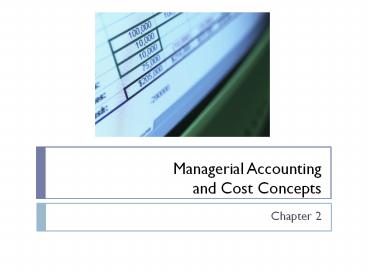Chapter 2 Powerpoint - PowerPoint PPT Presentation
1 / 24
Title:
Chapter 2 Powerpoint
Description:
Managerial Accounting and Cost Concepts Chapter 2 Chapter 2: Managerial Accounting and Cost Concepts. This chapter explains the differences and similarities between ... – PowerPoint PPT presentation
Number of Views:75
Avg rating:3.0/5.0
Title: Chapter 2 Powerpoint
1
Managerial Accounting and Cost Concepts
Chapter 2
2
Planning
Identifyalternatives.
2-2
3
Directing and Motivating
- Directing and motivating involves managing
day-to-day activities to keep the
organization running smoothly. - Employee work assignments.
- Routine problem solving.
- Conflict resolution.
- Effective communications.
2-3
4
Controlling
The control function ensuresthat plans are being
followed.
Feedback in the form of performance reportsthat
compare actual results with the budgetare an
essential part of the control function.
2-4
5
Planning and Control Cycle
Formulating long-and short-term plans (Planning)
Begin
Comparing actualto planned performance
(Controlling)
Implementing plans (Directing and Motivating)
DecisionMaking
Measuringperformance (Controlling)
2-5
6
Comparison of Financial and Managerial Accounting
2-6
7
Direct Materials
Raw materials that become an integral part of
the product and that can be conveniently traced
directly to it.
Example A radio installed in an automobile
2-7
8
Direct Labor
Those labor costs that can be easily traced to
individual units of product.
Example Wages paid to automobile assembly
workers
2-8
9
Manufacturing Overhead
Manufacturing costs that cannot be traced
directly to specific units produced.
Examples Indirect materials and indirect labor
2-9
10
Nonmanufacturing Costs
2-10
11
Product Costs Versus Period Costs
Product costs include direct materials, direct
labor, and manufacturing overhead.
Period costs include all selling costs and
administrative costs.
2-11
12
Balance Sheet
- Merchandiser
- Current assets
- Cash
- Receivables
- Merchandise Inventory
- Manufacturer
- Current Assets
- Cash
- Receivables
- Inventories
- Raw Materials
- Work in Process
- Finished Goods
2-12
13
Balance Sheet
- Merchandiser
- Current assets
- Cash
- Receivables
- Merchandise Inventory
- Manufacturer
- Current Assets
- Cash
- Receivables
- Inventories
- Raw Materials
- Work in Process
- Finished Goods
2-13
14
The Income Statement
Cost of goods sold for manufacturers differs
only slightly from cost of goods sold for
merchandisers.
2-14
15
Basic Equation for Inventory Accounts
2-15
16
Schedule of Cost of Goods Manufactured
Calculates the cost of raw material, direct
labor, and manufacturing overhead used in
production.
Calculates the manufacturing costs associated
with goods that were finished during the period.
2-16
17
Manufacturing Cost Flows
Income StatementExpenses
Balance
Sheet Costs
Inventories
2-17
18
Cost Classifications for Predicting Cost Behavior
- How a cost will react to changes in the level
of activity within the relevant range. - Total variable costs change when activity
changes. - Total fixed costs remain unchanged when activity
changes.
2-18
19
Variable Cost
Your total texting bill is based on how many
texts you send.
2-19
20
Variable Cost Per Unit
The cost per text sent is constant at 5 cents
per text.
2-20
21
Fixed Cost
Your monthly contract fee for your cell phone
is fixed for the number of monthly minutes in
your contract. The monthly contract fee does not
change based on the number of calls you make.
2-21
22
Fixed Cost Per Unit
Within the monthly contract allotment, the
average fixed cost per cell phone call made
decreases as more calls are made.
2-22
23
Cost Classifications for Predicting Cost Behavior
2-23
24
End of Chapter 2
2-24































